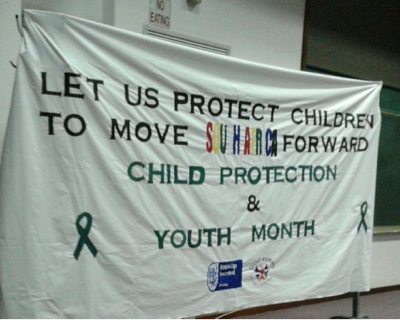This year our education district celebrated Heritage Day in the Cape Winelands. Our tour included a visit to the Madiba House, two museums in Paarl and the Taal Monument.
 |
| At the entrance to Drakenstein Correctional Services |
The first leg of our tour was a visit to Nelson Mandela's "gilded cage" at the Drakenstein Correctional Services. Nelson Mandela lived in what was a former farmer's house for 18 months before he was released on 11 February, 1990.
Madiba House
Warden Mr Fisher who has been working at Drakenstein Correctional Services for 31 years, was our tour guide. Being in our Madiba's house was surreal.
Our storyteller kept us spellbound with all the interesting details. We stood in the kitchen where Madiba's food was prepared.
 |
| Around the table where the negotiations took place. |
"Here was a massive microwave in the kitchen," said Mr Fisher. "When Mr Mandela saw the microwave the first time, he wanted to know why he needed a "television" in the kitchen as well. When the food was prepared, the chef had to eat of the food first. That was to check if the food was poisoned. Then, after about thirty minutes, if nothing happened to the chef, Mr Mandela's food would be heated in the microwave for him."
We crowded in the dining area at the table where the negotiations were held and off we went to the bedroom to see where Madiba had slept. Outside in the braai area, we saw the holes in the thatched canopies.
"The whole area including the braai area was bugged," said Warden Fisher.
The courtyard overlooks Simonsberg. When Mandela used to sit in the courtyard, gazing at the mountain, he remarked that the mountain looked like a sleeping giant. That is how Simonsberg became known as Simon, the sleeping giant.
 |
| Simon, the sleeping giant in the background. |
Tour of The Drakenstein Correctional Services
We were taken on a tour of the Drakenstein prison that operates on a sustainable model of self-sufficiency, according to our tour guide.
The Drakenstein Correctional Services is a farm prison that produces food to service the 42 prisons in the Western Cape. There is a piggery, an abattoir, chickens, cows and orchards. Interestingly, there are no vineyards nor bulls at the prison!
Every day, at about 3h00 their delivery trucks take the food to the other prisons.They train their own dogs and they make their own prison overalls. They also have their own purification system.
"Here inmates have to assist with the upkeep of the food, the grounds and everything else. We are here to give people a second chance. Our job is to rehabilitate the inmates so that they can be reintegrated with their families and their communities," said Warden Fisher.
At the end of our tour, we walked a few paces on "The Long Road to Freedom" and then took our pictures at the bronze statue of Madiba at the entrance.
Visits to Museums and the Taal Monument.
 |
| At the Taal museum |
Our next stop was a visit to the Paarl and Taal museums in Paarl. We learned about the history of the Afrikaans. Then our tour ended at the Taal monument. We learned that Afrikaans is the third largest language in South Africa. Zulu is the most spoken language and isiXhosa is the second largest language in our country.
 |
| At the Paarl museum |
Embrace your heritage.
Today's tour highlighted again the need for us to embrace our heritage. We need to create opportunities to visit our heritage sites or museums. In this way we can learn more about who we are and we will be inspired to celebrate our common lineage. Our heritage helps us understand how past experiences have shaped us and it sets the scene so that we can celebrate the creation of new experiences.
 |
| At the Taal Monument. |
Thanks to Izak Boonzaaier for shaping this Heritage Day experience for all of us. The weather was perfect, the tour buses were comfortable, the food was enjoyable and the company was amazing. What more can one ask for?
 |
| Izak Boonzaaier, the man behind the Heritage tour, and his colleagues. |
 |
| Our Director, Glen van Harte and me posing with Madiba. |










Comments
Post a Comment